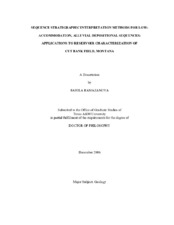| dc.contributor.advisor | Ayers, Walter B., Jr | |
| dc.contributor.advisor | Rabinowitz, Philip D. | |
| dc.creator | Ramazanova, Rahila | |
| dc.date.accessioned | 2010-01-14T23:58:34Z | |
| dc.date.accessioned | 2010-01-16T00:14:57Z | |
| dc.date.available | 2010-01-14T23:58:34Z | |
| dc.date.available | 2010-01-16T00:14:57Z | |
| dc.date.created | 2006-12 | |
| dc.date.issued | 2009-05-15 | |
| dc.identifier.uri | https://hdl.handle.net/1969.1/ETD-TAMU-1127 | |
| dc.description.abstract | In South Central Cut Bank Sand Unit (SCCBSU) of Cut Bank field, primary
production and waterflood projects have resulted in recovery of only 29 % of the
original oil in place from heterogeneous, fluvial sandstone deposits. Using highresolution
sequence stratigraphy and geostatistical analysis, I developed a geologic
model that may improve the ultimate recovery of oil from this field.
In this study, I assessed sequence stratigraphic concepts for continental settings
and extended the techniques to analyze low-accommodation alluvial systems of the Cut
Bank and Sunburst members of the lower Kootenai formation (Cretaceous) in Cut Bank
field. Identification and delineation of five sequences and their bounding surfaces led to
a better understanding of the reservoir distribution and variability.
Recognition of stacking patterns allowed for the prediction of reservoir rock
quality. Within each systems tract, the best quality reservoir rocks are strongly
concentrated in the lowstand systems tract. Erosional events associated with falling baselevel
resulted in stacked, communicated (multistory) reservoirs. The lowermost Cut Bank sandstone has the highest reservoir quality and is a braided stream parasequence.
Average net-to-gross ratio value (0.6) is greater than in other reservoir intervals. Little
additional stratigraphically untapped oil is expected in the lowermost Cut Bank
sandstone. Over most of the SCCBSU, the Sunburst and the upper Cut Bank strata are
valley-fill complexes with interfluves that may laterally compartmentalize reservoir
sands. Basal Sunburst sand (Sunburst 1, average net-to-gross ratio ~0.3) has better
reservoir quality than other Sunburst or upper Cut Bank sands, but its reservoir quality is
significantly less than that of lower Cut Bank sand.
Geostatistical analysis provided equiprobable representations of the
heterogeneity of reservoirs. Simulated reservoir geometries resulted in an improved
description of reservoir distribution and connectivity, as well as occurrences of flow
barriers.
The models resulting from this study can be used to improve reservoir
management and well placement and to predict reservoir performance in Cut Bank field.
The technical approaches and tools from this study can be used to improve descriptions
of other oil and gas reservoirs in similar depositional systems. | en |
| dc.format.medium | electronic | en |
| dc.format.mimetype | application/pdf | |
| dc.language.iso | en_US | |
| dc.subject | sequence stratigraphy | en |
| dc.subject | mature oil field | en |
| dc.subject | Cut Bank field | en |
| dc.subject | stochastic modeling | en |
| dc.subject | facies simulation | en |
| dc.subject | reservoir property | en |
| dc.subject | low-accommodation systems | en |
| dc.subject | alluvial systems | en |
| dc.subject | alluvial depositional setting | en |
| dc.subject | reservoir characterization | en |
| dc.subject | facies distribution/connectivity | en |
| dc.subject | lithofacies | en |
| dc.subject | geostatistical model | en |
| dc.subject | vertical proportion curve | en |
| dc.title | Sequence stratigraphic interpretation methods for low-accommodation, alluvial depositional sequences: applications to reservoir characterization of Cut Bank field, Montana | en |
| dc.type | Book | en |
| dc.type | Thesis | en |
| thesis.degree.department | Geology and Geophysics | en |
| thesis.degree.discipline | Geology | en |
| thesis.degree.grantor | Texas A&M University | en |
| thesis.degree.name | Doctor of Philosophy | en |
| thesis.degree.level | Doctoral | en |
| dc.contributor.committeeMember | Gibson, Richard L. | |
| dc.contributor.committeeMember | Jensen, Jerry L. | |
| dc.contributor.committeeMember | McVay, Duane A. | |
| dc.type.genre | Electronic Dissertation | en |
| dc.type.material | text | en |
| dc.format.digitalOrigin | born digital | en |


